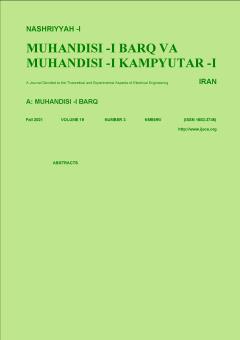Investigation of Leakage Current and Surface Temperature of 230 kV Composite Insulator Under the Influence of Moisture and Contamination Conditions
Subject Areas : electrical and computer engineeringSaman Mohammadnabi 1 , Khosrow Rahmani 2
1 -
2 -
Keywords: Composite insulator, particulate contamination, radiation cooling, COMSOL Multiphysics, leakage current,
Abstract :
As moisture condenses on the surface of the contaminated insulators, the electrical conductivity of the insulator surface increases, resulting in a leakage current on the surface and causing the insulators to fail. Condensation of moisture on the insulator surface occurs due to the mechanism of radiation cooling, mainly in the early mornings of winters. In this case, the temperature of the insulator surface is lower than the dew point. In this paper, a sample of real fine dust collected from the dust center and chemical analysis and measurement of electrical conductivity in the wet state were performed. By simulating a 230-kV contaminated composite insulator in COMSOL Multiphysics software, the magnitude of leakage current was obtained and verified by an experimental test. Also, using heat transfer governing relations, the temperature of the insulator surface during the leakage current flow, was determined and compared with the images captured by the thermo-vision camera during the test. The results show that the leakage current and the surface temperature of the insulator increase with increasing the conduction and thickness of the contamination layer and consequently the probability of insulator failure also increases. Experimental testing shows that simulation of insulators with finite elements-based commercial software can be a reliable method for pre-analysis of insulators.
[1] S. M. Kumar and L. Kalaivani, "Electric field distribution analysis of 110 kV composite insulator using finite element modeling," in Proc. Int. Conf. Circuits, Power Comput. Technol. ICCPCT’14, pp. 136-141, Nagercoil, India, 20-21 Mar. 2014.
[2] M. El-Shahat and H. Anis, "Risk assessment of desert pollution on composite high voltage insulators," J. Adv. Res., vol. 5, no. 5, pp. 569-576, Sept.. 2014.
[3] D. S. Lopes, "Potential distribution along a 500 kV polymer insulator in presence of a pollution layer," in Proc. of the COMSOL Conf., pp. 112-117, Grenoble, France, 27-29 Oct. 2015.
[4] Y. Mizuno, K. Naito, Y. Suzuki, and M. Akizuki, "Voltage and temperature distribution along semiconducting glaze insulator strings," IEEE Trans. on Dielectrics and Electrical Insulation, vol. 6, no. 1, pp. 100-104, Feb. 1999.
[5] A. Arshad, S. G. Nekahi, M. Mcmeekin, and M. Farzaneh, "Effect of pollution layer conductivity and thickness on electric field distribution along a polymeric insulator," in Proc. of the COMSOL Conf., pp. 56-59, Grenoble, France, 27-29 Oct. 2015.
[6] A. Nekahi and S. G. Mcmeekin, "Effect of pollution severity on electric field distribution along a polymeric insulator," in Proc. IEEE 11th Int. Conf. on the Properties and Applications of Dielectric Materials, pp. 612-615, Sydney, Australia, 19-22 Jul. 2015.
[7] R. Chakraborty and S. B. Reddy, "Performance of silicone rubber insulators under thermal and electrical stress," IEEE Trans. Ind. Appl., vol. 53, no. 3, pp. 2446-2454, May/Jun. 2017.
[8] J. Dadashizadeh Samakosh and M. Mirzaie, "Flash-over voltage prediction of silicone rubber insulators under longitudinal and fan-shaped non-uniform pollution conditions," Comput. Electr. Eng., vol. 78, pp. 50-62, 2019.
[9] A. Z. El Dein, "Experimental techniques to simulate naturally polluted high voltage transmission line insulators," IEEE Trans. on Dielectrics and Electrical Insulation, vol. 21, no. 5, pp. 2199-2205, Oct. 2014.
[10] P. Charalampidis, M. Albano, H. Griffiths, A. Haddad, and R. T. Waters, "Silicone rubber insulators for polluted environments part 1: enhanced artificial pollution tests," IEEE Trans. on Dielectrics and Electrical Insulation, vol. 21, no. 2, pp. 740-748, Apr. 2014.
[11] H. Benguesmia, N. M. Ziou, and A. Boubakeur, "Experimental study of pollution effect on the behavior of high voltage insulators under alternative current," Front. Energy, vol. 11, pp. 1-9, 2017.
[12] Y. G. Pushpa and N. Vasudev, "Artificial pollution testing of polymeric insulators by CIGRE round robin method-withstand & flashover characteristics," in Proc. 3rd Int. Conf. Cond. Assess. Tech. Electr. Syst., pp. 270-274, Rupnagar, India, 16-18 Nov. 2018.
[13] I. A. Joneidi, A. A. Shayegani, and H. Mohseni, "Electric field distribution under water droplet and effect of thickness and conductivity of pollution layer on polymer insulators using finite element method," Int. J. Comput. Electr. Eng., vol. 5, no. 2, pp. 266-270, Apr. 2013.
[14] Y. Bourek, N. M'Ziou, and H. Benguesmia, "Prediction of flashover voltage of high-voltage polluted insulator using artificial intelligence," Trans. Electr. Electron. Mater., vol. 19, pp. 59-68, 2018.
[15] N. A. Othman, M. A. M. Piah, and Z. Adzis, "Space charge distribution and leakage current pulses for contaminated glass insulator strings in power transmission lines," IET Gener. Transm. Distrib., vol. 11, no. 4, pp. 876-882, Mar. 2017.
[16] IEC 60507 Standard, Artificial Pollution Tests on High-Voltage Insulators to Be Used on AC Systems, Int. Electrotech. Comm. Geneva, Switzerland, 1991.
[17] CIGRE C4.303, Artificial Pollution Test for Polymer Insulators Results of Round Robin Test, Technical Brochure, 555#, Oct. 2013.
[18] ب. شفیعی و ا. میرزایی، "طراحی بهینه، ایمن و اقتصادی سیستم زمین پستهای فشارقوی،" مجله مهندسی برق و الکترونیک ایران، جلد 13، شماره 1، صص. 122-109، 1395.
[19] ع. نادریان جهرمی، م. صنایعپسند و ح. محسنی، "طراحی حلقه کرونای مقرههای پلیمری فشارقوی بر اساس شبیهسازی شدت میدان الکتریکی،" مجله مهندسی برق و الکترونیک ایران، سال 2، شماره ۲، صص. 38-30، پاییز و زمستان ۱۳۸۴.
[20] M. A. Salam, S. M. Al-Alawi, and A. A. Maqrashi, "Prediction of equivalent salt deposit density of contaminated glass plates using artificial neural networks," J. of Electrostatics, vol. 66, no. 9-10, pp. 526-530, Sept. 2008.
[21] T. S. Eriksson and C. G. Granqvist, "Radiative cooling computed for model atmospheres," Applied Optics, vol. 21, no. 23, pp. 4381-4388, Dec. 1982.
[22] Wijayatilake ACS, "Reviewing of insulator selection criteria for overhead power lines in coastal areas of Sri Lanka," Engineer, XLVII, 01, pp. 57-73, 2014.


